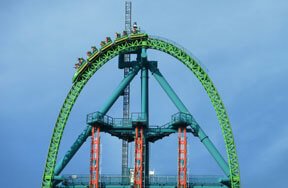The Seven Natural Wonders of the World weren't made by humans, but were created by Mother Nature. Learn more about these amazing natural wonders!
Seven Natural Wonders - Grand Canyon
The Grand Canyon is a rocky gorge (ravine) in Arizona, USA. It was created by millions of years of wind and water erosion from the Colorado River, which cut through layer after layer of sediment. The rocks of the canyon walls range from 250 million years old at the top to over 2 billion years old at the bottom. Each layer of rock represents a distinct geological period of the Earth's past.
Seven Natural Wonders - Paricutin Volcano
Paricutin Volcano erupted out of a cornfield on February 20, 1943. Located just outside a city called Michoacan, about 200 miles west of Mexico City, Paricutin grew to 10,400 feet in just nine years, making it the fastest growing volcano ever recorded in history. Lava flows destroyed two villages and hundreds of homes, but caused no fatalities (although three people died from lightning associated with the eruption).
Seven Natural Wonders - The Harbor at Rio de Janeiro
On the east coast of Brazil lies a picturesque scene of towering mountains and beautiful beaches. Portugese explorers were the first Europeans to see the Harbor, also known as Guanabara Bay, on January 1, 1502. They thought they had reached the mouth of an immense river and named it Rio de Janeiro, which means River of January. Landmarks include Sugarloaf Mountain and Corcovado Peak, which is the site of a gigantic statue of Jesus Christ.
Seven Natural Wonders - Northern Lights
Northern Lights, also called Aurora Borealis, are nature's fireworks. This spectacular light show takes place in the northern regions, but can be seen from many parts of the world. They occur when solar particles from the sun collide with gases in Earth's atmosphere. The collision energy between the solar particle and the atmospheric gas is emitted as a photon (light particle). When there are many collisions, you have an aurora - lights that seem to dance across the sky.
Seven Natural Wonders - Victoria Falls
On the African border of Zambia and Zimbabwe, the tranquil Zambezi River suddenly plummets 420 feet over a cliff to form the world's largest waterfall. Victoria Falls has five different parts - Devil's Cataract, Cataract Island, Main Falls, Rainbow Falls and Eastern Cataract. David Livingstone, a Scottish missionary, was the first white man to see the waterfall in 1855. Although he named it after the Queen of England, native Africans continue to call it Mosi-oa-Tunya, which means The Smoke that Thunders, because the water makes thunderous spray clouds as it falls.
Seven Natural Wonders - Mt. Everest
About 60 million years ago, India was a separate continent that rapidly moved northward and collided with Asia. The crash pushed up the northern rim of India to create the highest mountain range in the world known as the Himalayas. Mt. Everest stands above the other mountains at 29,035 feet, making it the tallest on the planet. Thousands of people have tried to climb the treacherous mountain (it's 97 degrees below freezing!) - more than 700 have succeeded, but at least 150 have died trying.
Seven Natural Wonders - Great Barrier Reef
The world's largest coral reef is located in the Coral Sea off the coast of Queensland in Australia. It stretches over 1,400 miles in length and can be seen from space. An estimated 1,500 species of fish and 350 types of coral live and grow on the Great Barrier Reef.































